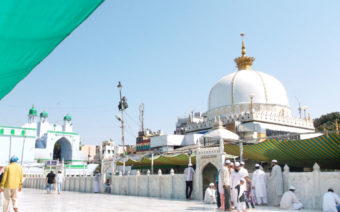A Day in Ajmer – What to see?

Located around the very funnily named ‘Nag Pahar’ or Snake Mountain in the Aravali Hills, Ajmer is an otherwise unattractive town and most travellers prefer to make a pit-stop on the way to Pushkar. Ajmer is said to have been founded in the 7th Century. Ajmer is home to the most sacred Islamic shrine in India, and for Muslims, a pilgrimage here is considered second in importance only to a visit to Mecca in Saudi Arabia.
Must Visit Places if You Have 24 Hours in Ajmer :
1- Khwaja Moinuddin Chishti Dargah or Dargah Sharif:
This 13th Century Dargah is the holiest Muslim shrine in India and is thronged by thousands of pilgrims every day. The slender path to the Dargah is lined with flower stalls and shops selling prayer paraphernalia, biryani shops to donate food to the poor and lanes that give the impression of having arrived in the 15th Century.
2- Taragarh Fort
Strategically located, Ajmer was a very important town and the 12th Century Fort of Taragarh was established by the town’s founder Ajaypal Chauhan.
It is in a crumbling state these days but still has fine views of Ajmer from the top with the Ana Sagar Lake providing a beautiful backdrop. Taragarh Fort is only 3-4 km away from Ajmer and can be accessed by shared taxis or by a 90-minute walk from the Dhai Din Ka Jhopda.
3- Dhai Din Ka Jhopda
Dhai din ka Jhopda, literally ‘two-and-a-half-day hut’, is unquestionably the oldest surviving monument in Ajmer. It was originally built in 660 AD as a Jain Temple and was converted into a Sanskrit School in 1153. Locals claim that the name has stuck because it was built in 2 & 1/2 days, but it seems more like a legend than truth.
4- Akbar Fort & Museum
This was constructed in 1570 and was originally named Daulat Khana by Akbar. When the British were in power, they maintained a large garrison inside the fort. The Fort is important from a historical point of view, in 1660 the British got a toehold in India when Sir Thomas Roe, a representative of the British East India Company, met Emperor Jahangir and gained his permission to establish the first British factory at Surat, at this fort.
5- Ana Sagar Lake & Baradaris
The Ana Sagar is an artificial lake that spreads far and wide with the town of Ajmer. It was laid out in the twelfth century and is worth a visit to see the line of elegant white-marble pavilions called baradaris, or summer shelters. These were built in the 17th Century by Shah Jahan on the lake’s banks, in a garden by the name of Daulat Bagh.
6- Nasiyan (Red Temple) or Soni Ji Ki Nasiyan
Locally called ‘red temple’, Nasiyan was built in 1865 by a rich merchant. While the building is totally unassuming from the outside, when I ascended the stairs to the second floor I was taken aback by the sheer grandeur and golden opulence. It seemed like a fantasy world.


